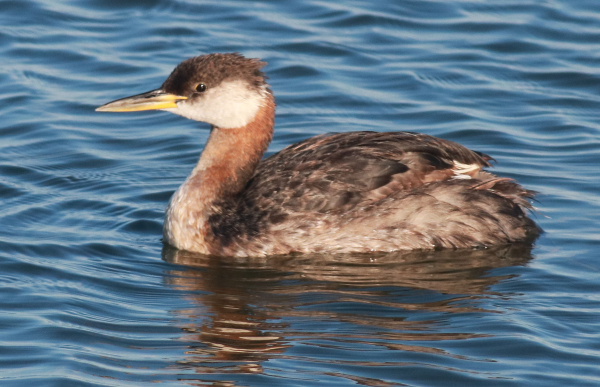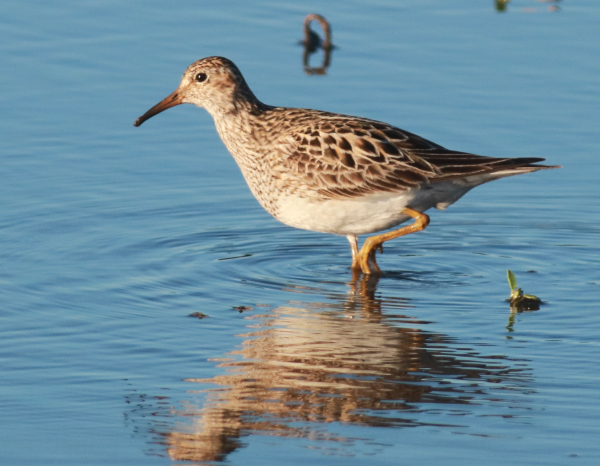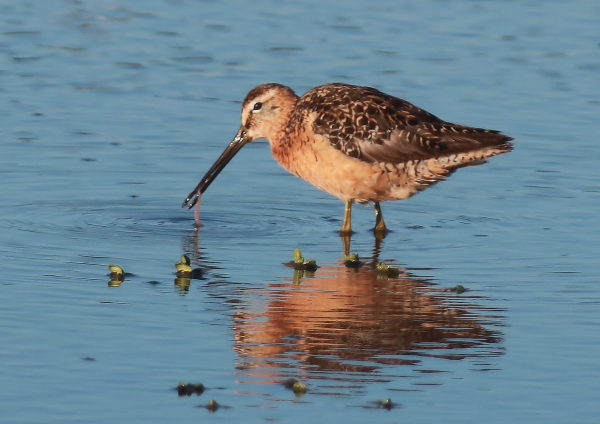


|
It was a beautiful evening to share with an ever-mixing variety of birds, primarily shorebirds stopping over after their Arctic nesting season, plus others. The still water on the small rainwater pond mirrored the blue sky and provided a beautiful backdrop for the colorful Long-billed Dowitchers, Semipalmated Sandpipers, Pectoral Sandpipers, and the first Semipalmated Plovers of the year – all just a few feet away. In addition to these Arctic migrants a Lesser Yellowlegs joined the mix, along with a Willet, Franklin’s Gull, fledgling Black Tern, and a host of Killdeer, including two downy hatchlings. The tranquil pond, created by rainfall the past two nights, is located just three miles south of my office, and is now sustaining this enjoyable variety of birds.
A couple weeks ago, I reported on a similar rainwater mudflat located just a quarter-mile southwest of my office. Well, it’s back again too, and has attracted many of the same birds. These short-lived “ephemeral” wetlands only last a few days in some cases, depending on local conditions, and they are not widespread in this area or elsewhere in the hundreds of square miles I check out each week. How lucky am I to have two such interesting rainwater ponds so close – with such exciting birds that allow me to observe and photograph them from just a few feet away!
In addition to the Semipalmated Plovers, recent new birds in the area included two first-of-year birds: A Chestnut-collared Longspur and a Red-necked Grebe (see photo). I only managed a glimpse of the little longspur – a rare sighting in my area – but just as rare in this region, the grebe was very approachable as well as photographable.
Last Tuesday, I checked back on some interesting birds – first the feisty pair of Swainson’s Hawks I observed 6 miles northwest of home. Although I found no Swainson’s, I did see an adult Krider’s Red-tailed Hawk, and was very surprised to find a new pair of Red-headed Woodpeckers where I last viewed the Swainson’s. I have seen the woodpeckers during two subsequent visits to the area, and know the approximate location of the nesting cavity that must hold their growing brood as the adults feed and care for them.
It’s nice to have these Red-heads so close, considering my other nesting pairs of Red-headed Woodpeckers are an average of 25 miles away to the southwest (29 miles from the new nest site). But that wasn’t the only new pair! I found another new pair of Red-headed Woodpeckers about 8 miles south of my Red-head hotspot. Last year, after finding 3 nesting pairs of Red-heads in the hotspot area, I searched many miles of surrounding landscape without finding any others. This year, it may be worthwhile to expand my search around the hotspot again.
I found the southern-most pair of woodpeckers as I returned from a longer than usual evening drive Tuesday eve, with the hope of re-finding the partial-albino Mourning Dove I reported last week. I searched diligently as best I could, but was unable to relocate the pied dove. Knowing me quite well, I’d bet I’ll check another time, or two.
Last Wednesday during my weekly trip to McKenzie and the wetlands east of Bismarck, there were plenty of new broods: Gadwalls, Redheads, Northern Shovelers, and especially Ruddy Ducks, along with broods of Mallards, Northern Pintails, Canvasbacks, Northern Shovelers, Blue-winged Teal, Redheads, and Wood Ducks. Now there are also plenty of older broods, much older. Some ducklings are fully feathered and hard to distinguish from females of their species, or the drakes that are now in their summer eclipse plumage.
McKenzie Slough continued to draw down along the edges, with continuing shorebirds feeding in considerable numbers. Noteworthy among them were a number of Stilt Sandpipers, also first-of-year species (what a surprising week for new birds). Other notable observations included a second Krider’s Red-tailed Hawk about half way to Bismarck on Wednesday, and a big female Ferruginous Hawk about 18 miles south of home Tuesday evening.
My regular feeding station visitors have been very spotty during the past week, including Orchard Orioles, but fledgling Baltimore Orioles are more common. Two species provided sketchy appearances – Ruby-throated Hummingbirds and Blue Jays. I enjoyed a few hummingbird visits for about four days, but haven’t seen any since last Thursday, and after an absence of 6 days, a family of Blue Jays has been active at the feeding station again since Saturday – they seem to be the same birds that were regular two weeks ago.
Birds sure are fickle this time of year, but that’s part of the fun, whether it’s a first-of-year sighting, a new collection of birds at a rainwater pool, or the orioles at my nectar and grape jelly feeders. It’s also that time of the year when there are many changes taking place among bird populations. It’s exciting to still find new woodpecker nesting territories, along with roaming hawks, and a variety of duck broods. My thought for the day Monday was: “When will a falcon arrive, attracted by the influx of shorebirds and passerines?” The arrival of a Merlin, Prairie, or Peregrine can’t be too far off. Keep an eye to the sky and your binoculars and camera within reach!
Article and photos by Paul Konrad
Share your bird sightings and photos at editorstbw2@gmail.com